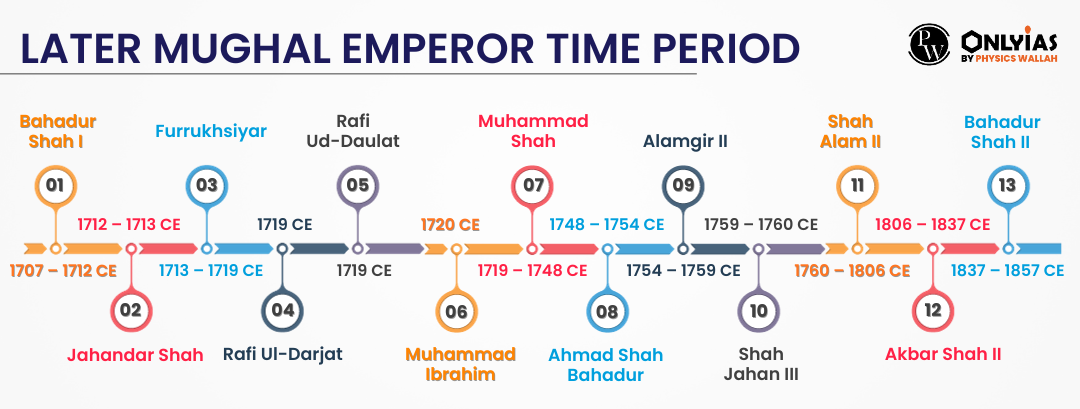| List of Mughal Emperor: Order, Ruler, Reign & British Arrival |
The Rise and Fall of the Mughal Empire
Founded by Zahiruddin Babur in 1526 and expanded to its full glory by Emperor Akbar in the second half of the sixteenth century, the Mughal Emperor began to decline rapidly after the death of its last great ruler Aurangzeb in the year 1707. Afterwards, a number of weak rulers ascended the Mughal Emperor throne but these rulers were not as capable as their predecessors. Their incapable leadership coupled growing socio-economic and geo-political scenarios like rise of regional states led to their ultimate downfall in 1857.

| Mughal Emperors |
Description |
| Bahadur Shah I (1707-1712) |
- He adopted a pacific policy with Marathas, Rajputs and Jats.
- Short reign marked by political instability and regional revolts.
- The Maratha prince Shahu, was released from Mughal Emperor captivity.
- Rajput chiefs were confirmed in their respective states.
- He initially attempted to appease the Sikhs by granting high mansabs to Guru Gobind Singh.
- However, subsequently, he quelled a revolt led by Banda Bahadur, who succeeded Guru Gobind Singh.
- The Sikh leader Banda Bahadur attacked the Muslims in Punjab, and, hence, the emperor took action against him.
- Khafi Khan gave the title of ‘Shah-i-Bekhabar’ to Bahadur Shah
|
| Jahandar Shah (1712-1713) |
- Ascended the throne with the help of Zulfikar Khan
- Zulfikar Khan was appointed prime minister or Wazir
- He introduced the izara system to improve the financial condition of the empire.
- He abolished jizya.
|
| Farrukhsiyar (1713-1719) |
- Ascended the throne after killing Jahandar Shah with the help of Sayyid brothers-Abdulla Khan and Hussain Ali (known as ‘King Makers’).
- He followed a policy of religious tolerance by abolishing jizya and pilgrimage tax.
- In 1717, he gave farmans to the British known as Magna Carta of British rule in India
- In 1719, the Sayyid brothers, with the help of Peshwa Balaji Vishwanath, blinded and killed Farrukhsiyar.
- It was the first time in Mughal Emperor history that an emperor was killed by his nobles.
|
| Rafi Ul-Darjat (1719) |
- Brief reign, died of illness.
|
| Rafi-ud-Daula or Shah Jahan II (June 6-September 17, 1719) |
- The new emperor was an opium addict.
- Extremely brief reign, ruled for a few months.
|
| Muhammad Shah (1719-1748) |
- He was named ‘Rangeela’ because of his lavish lifestyle.
- Ascended the throne with the help of Sayyid Brothers.
- Reign marked by administrative decay, weakening of central authority, and emergence of regional powers.
- In 1724, Nizam-ul-Mulk became the wazir and founded the independent state of Hyderabad.
- In 1737, Baji Rao-I, the Maratha Peshwa, invaded Delhi with a small army of 500 horsemen.
- In 1739, Nadir Shah defeated the Mughal Emperor in the Battle of Karnal.
|
| Ahmad Shah Bahadur (1748-1754) |
- Ascended after Muhammad Shah’s death.
- Ahmad Shah was an incompetent ruler who left the state affairs in the hands of Udham Bai, the ‘Queen Mother’.
- Udham Bai, given the title of Qibla-i-Alam, was a lady of poor intellect who ruled with the help of her paramour, Javid Khan (a notorious eunuch).
- He faced challenges from regional powers and foreign invasions.
|
| Alamgir II (1754-1759) |
- Ascended after a period of political instability.
- Limited power due to influence of Marathas and other regional powers.
- Ahmed Shah Abdali, the Afghan invader, reached Delhi in January 1757.
- During his reign, the Battle of Plassey was fought in June 1757.
- Alamgir II was assassinated.
|
| Shah Jahan III (ruled 1759-60) |
- Also known as Muhi-ul-millat, he was placed on the throne as a result of the intrigues in Delhi, but was later deposed through Maratha intervention
|
| Shah Alam II (ruled October 1760-July 1788; October 1788-November 1806) |
- Two decisive battles- the Third Battle of Panipat (1761) and the Battle of Buxar (1764).
- In 1765, according to the terms of Treaty of Allahabad (August 1765), he was taken under the East India Company’s protection and resided at Allahabad.
- In 1772, the Marathas took him to Delhi where he lived till 1803.
- In 1803, he again accepted the protection of the English, after the defeat of Daulat Rao Scindia by the English.
- Afterwards, the Mughal emperor became the pensioner of the English.
|
| Akbar Shah II (1806-1837) |
- Symbolic ruler under British suzerainty.
- He gave the title of ‘Raja’ to Rammohan Roy.
- In 1835, the East India Company discontinued calling itself subject of the Mughal emperor, and stopped issuing coins in the name of the Mughal emperor.
|
| Bahadur Shah II (1837-1858) |
- Last Mughal Emperor.
- Faced the Indian Rebellion of 1857, after which the British deposed him, marking the official end of the Mughal Empire.
- He was captured by the English and sent to Rangoon where he died in 1862.
- He was a great poet (shayar) himself.
- Mirza Ghalib (great urdu poet) resided in his court.
|
Conclusion:
- The period of later Mughal Emperor rulers from 1707 to 1857 represents a chapter of decline and disintegration for the once-proud Mughal Empire.
- While elements of cultural and artistic brilliance persisted, they were overshadowed by a combination of internal strife, external pressures, and administrative decay.
- This period ultimately paved the way for a new phase in India’s history, as the British colonial era took hold, forever changing the course of the subcontinent’s development.
Also Read: Aurangzeb’s Legacy: Decline of the Mughal Empire































